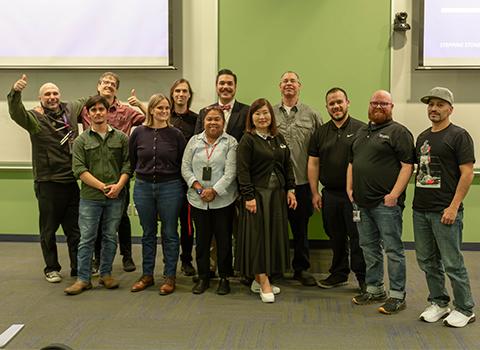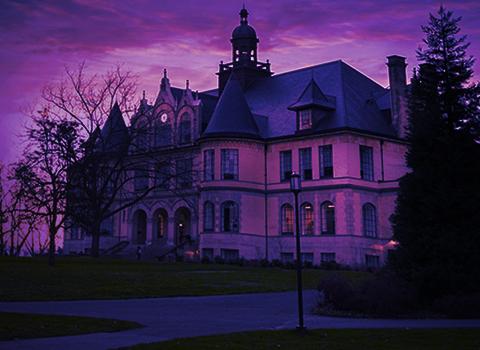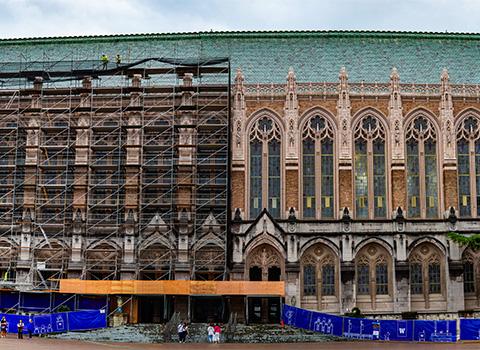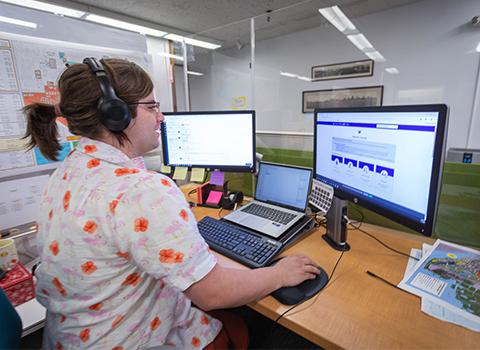Securing Suzzallo for the Big One
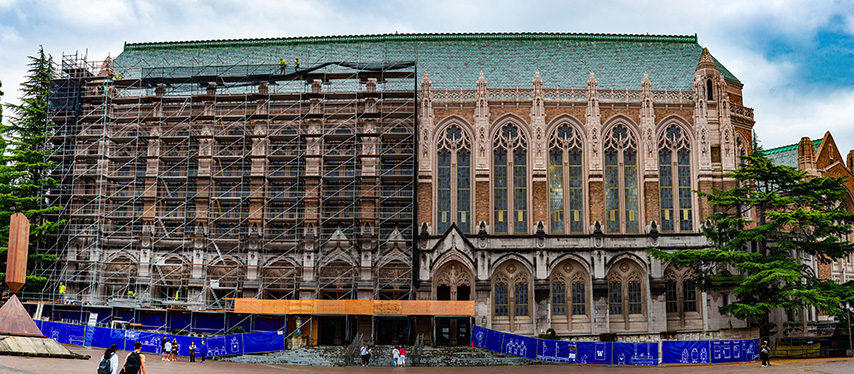
Scaffolding started to go up in front of Suzzallo Library in early August. The building's facade is now completely covered by the scaffolding and black netting. Pamela Dore/University of Washington
Suzzallo Library has been called a “cathedral of books,” evoking the churches of medieval Europe. Its pointed arches, intricate statues and graceful towers and pinnacles, capped by decorations called finials, make it a fine example of Collegiate Gothic architecture, popular at the time the library was constructed.
But those same features could become deadly objects if a big earthquake strikes.
“In a massive earthquake, the towers could shake enough to where an entire finial or other masonry element could crack and fall off,” said Andrew Ellis. “And it essentially becomes a falling projectile and a life safety hazard, particularly when people are running out of the building.”
Ellis is the design manager for GLY Construction, the company contracted with UW Facilities’ Project Delivery Group, which is responsible for the delivery of UW’s capital projects — including conception, construction, occupancy and more. Bassetti Architects and Degenkolb Engineers are also contracted for the project. They are working together to make seismic and other improvements to the exterior of Suzzallo’s historic architecture.
How Suzzallo withstood the Nisqually earthquake
How Suzzallo withstood the Nisqually earthquake
The Suzzallo construction project taking place now makes improvements to the library’s two oldest wings. The 1925 wing faces Red Square to the west, while the 1935 wing faces NE Grant Lane to the south.
In 2000, the entire library, which also includes a 1947 and 1961 addition, went through a seismic retrofit that secured the building from major structural damage. When the Nisqually earthquake hit the Puget Sound region in 2001, while the project was in process, the building didn’t suffer significant damage.
But four finials did fall 70 feet to the steps below. The work underway ensures that won’t happen again.
The earlier retrofit, focusing on the building’s primary structural system, took two years to complete. The retrofit taking place now, focusing on securing its exterior masonry features, started in mid-June and is scheduled to end in August 2026. Projected to cost $21.5 million, it’s part of Phase 5 of a series of seismic improvements the Project Delivery Group is overseeing across campus. Improvements to Hec Edmundson Pavilion and the Art Building are also part of this phase.
The first step is securing the overall exterior of the building, putting thousands of pins into the walls to stitch it together. This ensures that the different types of masonry, including cast stone, brick, sandstone and terracotta, will move as one with the rest of the building, instead of independently and potentially dislodging if there’s an earthquake. Workers will also go brick by brick and replace mortar that’s been damaged or has deteriorated due to age.
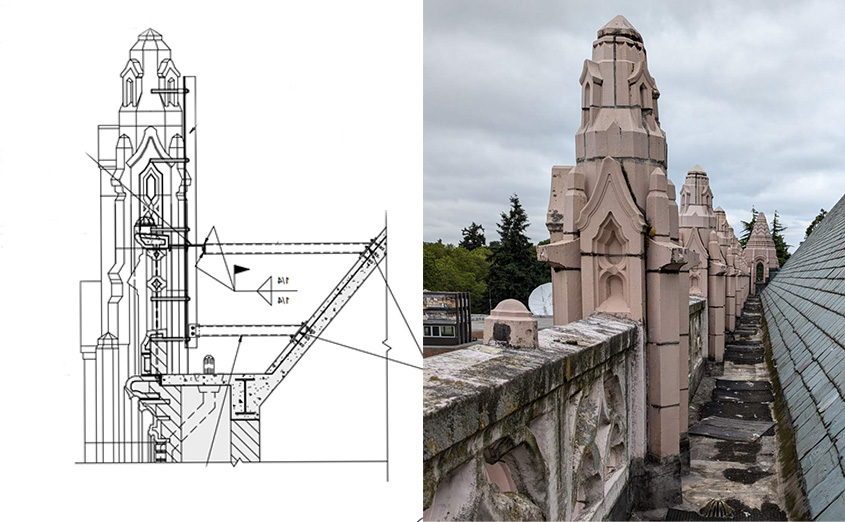
A finial on the roof of Suzzallo and a diagram of how it will be secured to the roof. Bassetti Architects, Degenkolb Engineers
Next, they’ll secure the building’s decorative elements. Steel reinforcements will strengthen the towers sitting atop the library’s 1925 wing, carefully placed in their interiors to preserve their unique look. The towers flanking the 1935 wing will be fully dismantled and reconstructed. To brace the finials that run along the top of the building, tube steel anchors will tie them to the sloping roof.
Suzzallo’s 18 statues — encompassing a who’s-who of “great thinkers” — will also be pinned to the structure of the building.
“It's great that the UW is doing this seismic work,” said Ellis of GLY. “It’s one of those things where it's not a problem, until it's a really big problem.”
While the damage to Suzzallo was minimal, the Nisqually Earthquake shows why it’s important to systematically address these issues — as an even bigger earthquake looms as a threat in the future.
Giving Suzzallo a facelift
Giving Suzzallo a facelift
Scaffolding went up around Suzzallo earlier this month, obscuring the famous facade with black netting. While that may disappoint Huskies looking for an iconic UW photo, it also presents opportunities to make other long-overdue improvements.
Like giving the outside of the library a good cleaning, something that hasn’t been done “in recent memory as far as we can tell,” said Ellis.
Black staining and mold mark much of the building’s exterior, and ferns grow out of masonry that has cracked, retaining moisture. There’s also discoloration at the windows, which contractors will survey for other repairs. Masonry damaged by previous earthquakes will be fixed to prevent further deterioration and ensure it remains intact and in place.
Workers will also replace slate and install waterproofing systems on the roof. This has already presented some unique challenges.
Seagulls sometimes nest on Suzzallo’s roof, and these birds and their nests are protected by state and federal wildlife regulations. To prevent construction delays and human-wildlife conflict, staff worked with UW Environmental Health & Safety to apply more natural methods to deter gull nesting in the area this year.
This included placing bird excluders in some rooftop areas prior to nesting season. The Project Delivery Group also contracted with a company called Airstrike Bird Control Inc. to bring an abatement falconer and trained Harris's Hawk to the library roof. The pair came four times a week from early April through June to conduct early non-contact harassment of the gulls and successfully deter nesting interest in the work area.
A falconer is only one example of the specialty workers who are part of the project, which will include 40 or 50 workers onsite at peak times and many others across the country, including preservationists, specialty terracotta producers, abatement contractors, two sets of masons, technical structural engineers and more.
In the end, after all the time, money and people involved, most people won’t even notice the work that’s gone into it, said Pasqual Contreras, UW’s project manager for the retrofit.
If the project is done right, the building will look exactly the same — and that’s the point.
“The building was constructed in 1925 and opened in 1926 — so next year is the 100th year of the library,” Contreras said. “We won’t complete this work in time for the anniversary, but we are preserving the library to survive for the next 100 years.”
